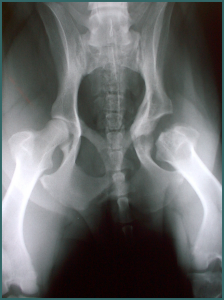Orthopedic Surgery
Femoral Head & Neck Ostectomy
Learn more about femoral head & neck ostectomy below.

Femoral Head & Neck Ostectomy

Canine Hip Dysplasia is associated with the abnormal formation of the hip socket that can lead to crippling lameness and painful arthritis. This severe degenerative joint disease is often diagnosed with the help of radiographs (x-rays). Dogs affected with hip dysplasia are often shown to have laxity present between the femoral head and acetabulum, which results in incongruent joints. This subluxation can cause soft tissue damage, severe cartilage erosion, and boney malformation resulting in osteoarthritis and degenerative joint disease. If left uncared for, this cartilage degeneration could lead to full cartilage loss, resulting in bone-on-bone contact. Removal of a smooth gliding surface in the joint and exposed nerve endings on the bone makes this extremely painful. Varying treatment options exist depending on the patient’s age, comfort and activity levels, and hip joint degeneration stage. Once end-stage degeneration occurs, surgical treatment options are limited to a total hip replacement and a femoral head and neck ostectomy.
Procedure:
Our veterinarians advise an FHO for end-stage or severe CHD. During this procedure, the painful arthritic or dislocated hip joint is removed, eliminating the bone-on-bone contact. Fibrous tissues and the remaining joint capsule help hold the limb in place, while a pseudoarthrosis (false joint) replaces the pre-existing hip joint. This procedure is generally regarded as most effective in smaller patients; however, no definitive size limitations exist.
Outcome:
With appropriate patient and post-operative physical therapy selection, the outcome for patients receiving an FHO can be highly successful. Though the procedure does not give them a “new hip,” it does allow for a more comfortable range of motion following the surgery. The outcome of this procedure is mainly dependent on the severity of the condition pre-operatively and the level of aftercare provided following the surgery.
FHO For The Treatment of Trauma:
In some circumstances, an FHO can also be used as a treatment for severely fractured acetabular (hip socket) injuries, femoral head, and neck fractures or luxations. This procedure may simplify repair or recovery in patients following severe trauma, especially if multiple other injuries exist.
The radiograph below shows a patient with a right acetabular fracture (hip joint on the right side of the picture). An FHO was performed (radiograph below), and the pelvis went on to achieve boney union.

